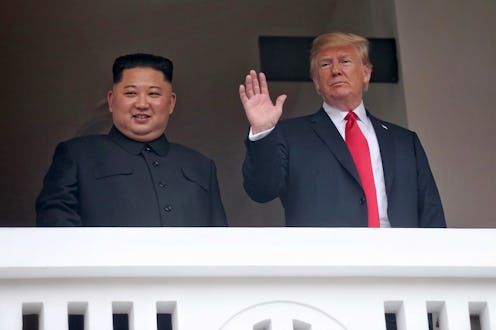News
Trump Might Continue His Budding Bromance With Kim Jong Un — At The White House

According to Donald Trump's analysis after his series of photo-ops and meetings with North Korean dictator Kim Jong Un, things went very well. And now, it seems as though the president would like to continue to build the relationship. While it's still unclear if Kim Jong Un will visit the White House, Trump has already said that he would "absolutely" extend that invite to the leader.
“We’re very proud of what took place today,” Trump said as he was sitting next to Kim.
Trump said that "a very special bond" had developed between the two of them, and that the meeting went "better anybody could have expected." Trump did not provide any details about when that invitation would come or what a potential meeting at the White House could entail, but that's not the only vague promise to have come out of that meeting.
Trump and Kim signed a joint agreement in Singapore in which North Korea pledged to denuclearize and America promised to provide security guarantees in return. But according to the New York Post, the document that the two of them signed at the end of the summit also didn't contain any exact details about how they would work toward denuclearization in North Korea.
The document that they signed is notable, the Guardian reported, largely because it doesn't tie either country to any promises regarding denuclearization, and in fact only reaffirms the unfulfilled promises that North Korea has made in the past. If Kim were indeed to receive an invitation to the White House, however, this would not be the most controversial part of that invitation.
According to Human Rights Watch, Kim presides — as a despot with ultimate and devastating power — over "one of the most repressive authoritarian states in the world." Citizens of North Korea are prevented from leaving the country, heavily censored in terms of their own expression and their access to information from the outside world, and routinely subjected to various, serious forms of abuse from the government like imprisonment, rape, forced abortion, and even murder.
The New York Times described how Kim's government keeps its population in line, and his techniques are directly in line with the strategies that Stalinist dictatorships employed across Eastern and Central Europe before Stalin's death in the 1950s. For example, North Korea runs a network of gulags — prison work camps — where people can be sent for even the smallest infractions. The punishments don't stop there, however.
“I learned he’s a very talented man. I also learned that he loves his country very much," Trump said of Kim at the news conference following the summit. This glosses over Kim's method of governing, which included 340 executions in his first six years as Supreme Leader, according to the New York Times. As is typical in regimes of this nature, not even all of those executions happened to people who were public critics of the regime — instead, they're meant to inspire fear in the population and to keep people in line.
Hyon Yong Chol, according to the Times, was a general in the army, until he fell asleep in a meeting and was executed using an antiaircraft gun. Kim Yong Jin, once the deputy premier for education, was accused of being an “anti-party reactionary” who had carried out “modern-day factionalism” — all because he displayed “disrespectful posture” while meeting with Kim.
As CNBC explained, Trump blatantly ignored Kim's human rights abuses during the summit — and an invitation to the White House would sweep them under the rug even further. Meeting with the American president on equal terms was already a big win for Kim, as the Guardian wrote. It put the rogue, oppressive nation on an equal plane with the United States. This, in a way, functions as a justification of those human rights abuses — and an invitation to the White House would only intensify that.